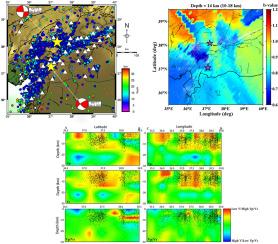Tomography of the source zone of the February 6, 2023, Kahramanmaraş Earthquake Doublets of Southern Anatolia
IF 2.2
4区 地球科学
Q2 GEOSCIENCES, MULTIDISCIPLINARY
引用次数: 0
Abstract
On February 6, 2023, two destructive earthquakes and many posterior aftershocks hit the Kahramanmaraş area in southern Anatolia. The Kahramanmaraş earthquake sequence (KMES) caused extensive damage and economic losses in Türkiye and Syria. In this study, the 3-D crustal seismic velocities surrounding the hypocentral region of the KMES are determined using a large dataset of body wave arrival times obtained from local earthquakes. To better constrain the physical properties and seismogenic behavior of the KMES source region, the Vp/Vs ratio is calculated and correlated with Poisson's ratio using the obtained velocity models. To gain a better understanding of the stress conditions and regional earthquake activity in the study area, the depth variation of the b-value is also examined. The velocity structure is generally heterogeneous with both low and high velocities at upper crustal depths. Along the East Anatolian Fault Zone and its environs, low-velocity anomalies are charted. Also, small b-values (<1.0) are estimated in the region encompassing the KMES, especially at upper crustal depths. The KMES source zone is characterized by low b-value, low to average Vp, low Vs, and average/high Vp/Vs ratios. Hit count rates and the resolution test show that the mapped velocity anomalies are robust down to a depth of 45 km. Therefore, the moderate/high Vp/Vs and small b-values at the upper and middle crustal depths along the EAFZ may give constraints on the next earthquake hazards of the study region. The present findings provide deeper insight into the physical properties and the seismogenic potential of the crustal zones in proximity to the active fault segments of the Anatolian Plateau and the northwestern part of Arabia.

2023年2月6日安纳托利亚南部kahramanmaraki地震双峰震源区的断层摄影
2023年2月6日,安纳托利亚南部的卡赫拉曼马拉伊地区发生了两次破坏性地震和多次余震。kahramanmaraki地震序列(KMES)在土耳其和叙利亚造成了广泛的破坏和经济损失。在这项研究中,利用从当地地震中获得的大型体波到达时间数据集,确定了KMES震源区域周围的三维地壳地震速度。为了更好地约束KMES震源区的物理性质和孕震行为,利用得到的速度模型计算了Vp/Vs比,并与泊松比进行了关联。为了更好地了解研究区的应力条件和区域地震活动,还研究了b值的深度变化。速度结构一般不均匀,在上地壳深处既有低速,也有高速。沿着东安纳托利亚断裂带及其周围,绘制了低速异常图。此外,在KMES周围区域,特别是在地壳上部深度,估计了较小的b值(<1.0)。KMES源区具有低b值、低至平均Vp、低Vs和平均/高Vp/Vs比值的特征。命中率和分辨率测试表明,映射的速度异常在深度为45 km的地方是稳健的。因此,沿EAFZ上、中地壳深度的中/高Vp/Vs和小b值可能对研究区下一次地震灾害起到约束作用。本研究结果对安纳托利亚高原和阿拉伯半岛西北部活动断裂带附近地壳带的物理性质和孕震潜力提供了更深入的认识。
本文章由计算机程序翻译,如有差异,请以英文原文为准。
求助全文
约1分钟内获得全文
求助全文
来源期刊

Journal of African Earth Sciences
地学-地球科学综合
CiteScore
4.70
自引率
4.30%
发文量
240
审稿时长
12 months
期刊介绍:
The Journal of African Earth Sciences sees itself as the prime geological journal for all aspects of the Earth Sciences about the African plate. Papers dealing with peripheral areas are welcome if they demonstrate a tight link with Africa.
The Journal publishes high quality, peer-reviewed scientific papers. It is devoted primarily to research papers but short communications relating to new developments of broad interest, reviews and book reviews will also be considered. Papers must have international appeal and should present work of more regional than local significance and dealing with well identified and justified scientific questions. Specialised technical papers, analytical or exploration reports must be avoided. Papers on applied geology should preferably be linked to such core disciplines and must be addressed to a more general geoscientific audience.
 求助内容:
求助内容: 应助结果提醒方式:
应助结果提醒方式:


